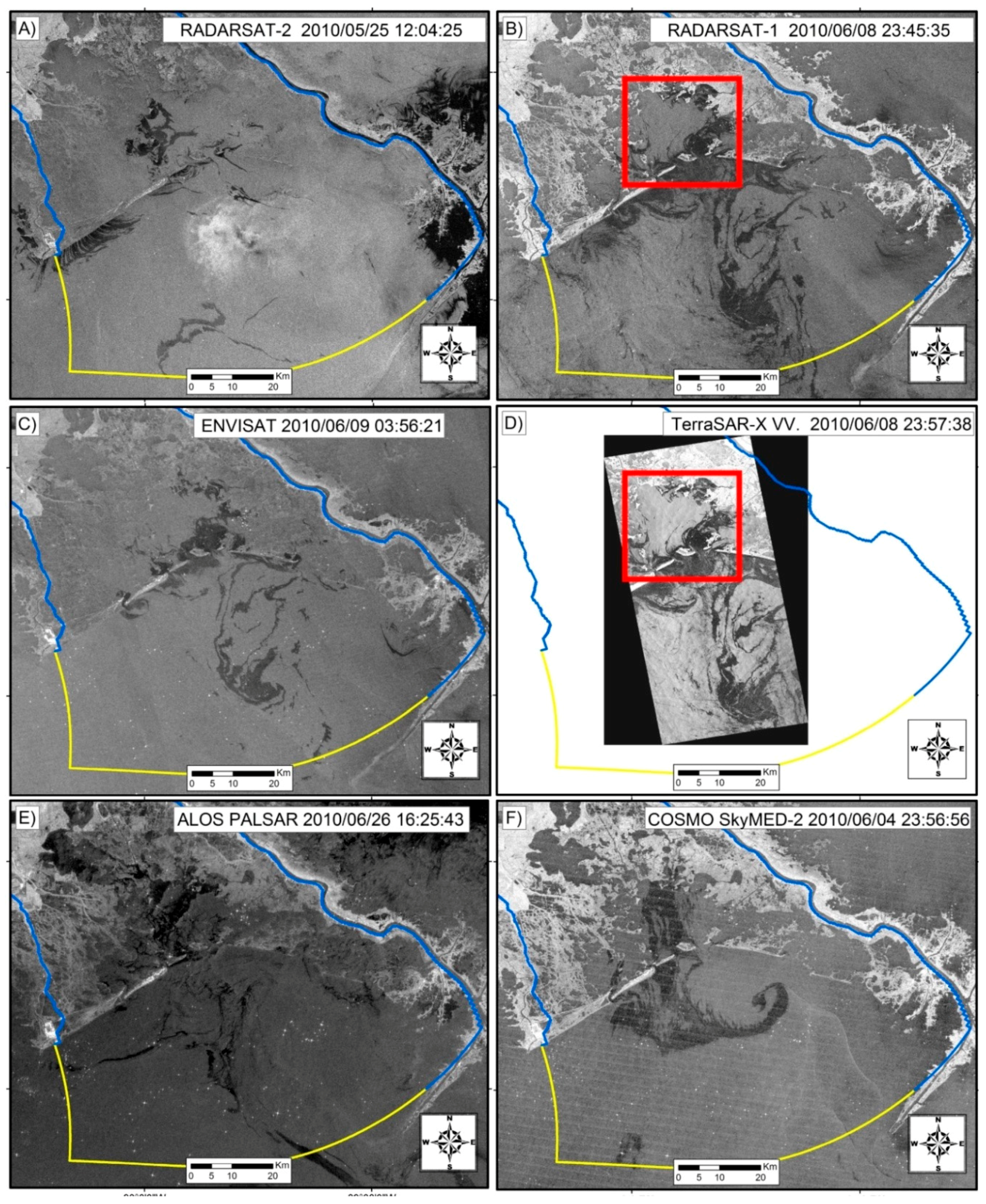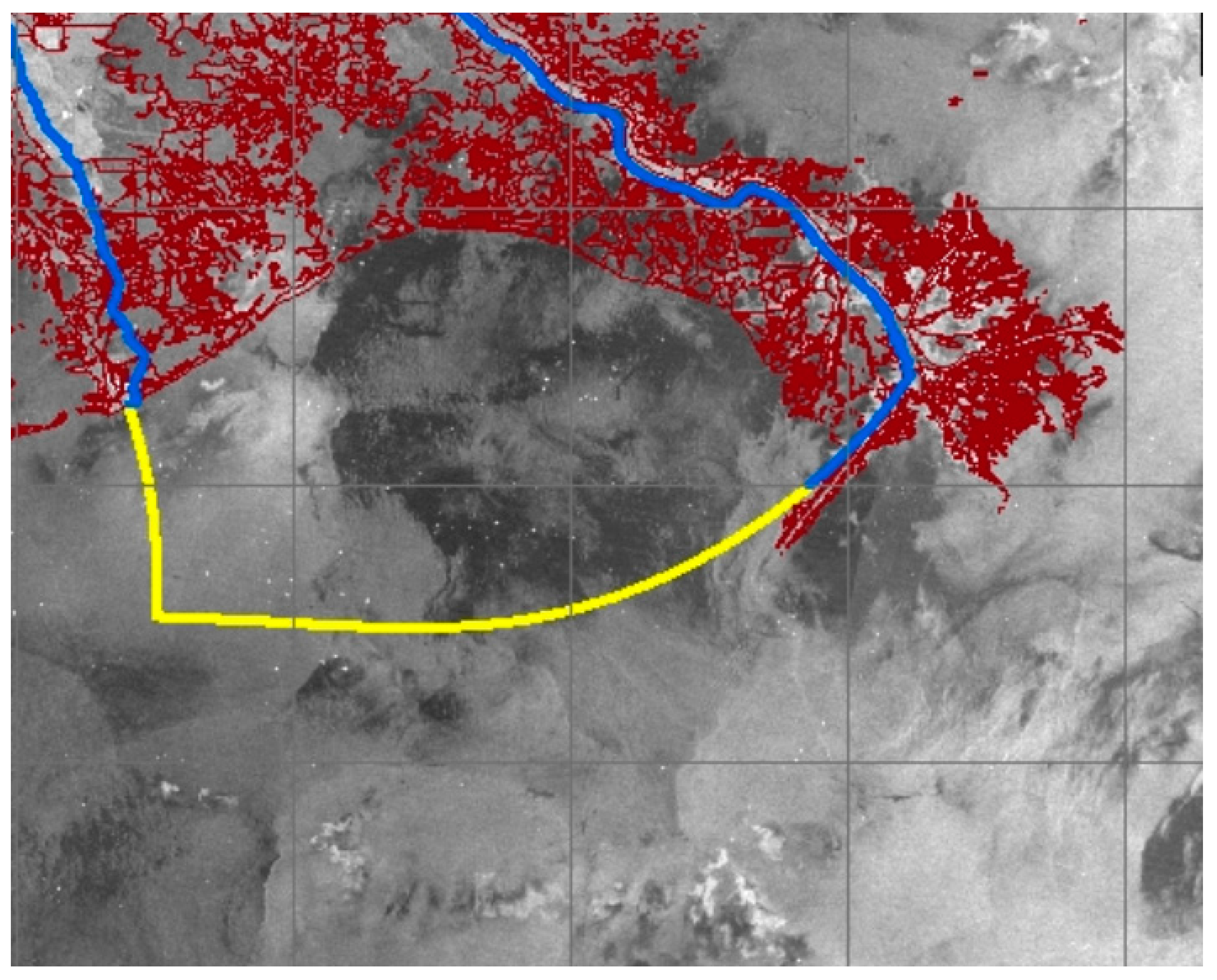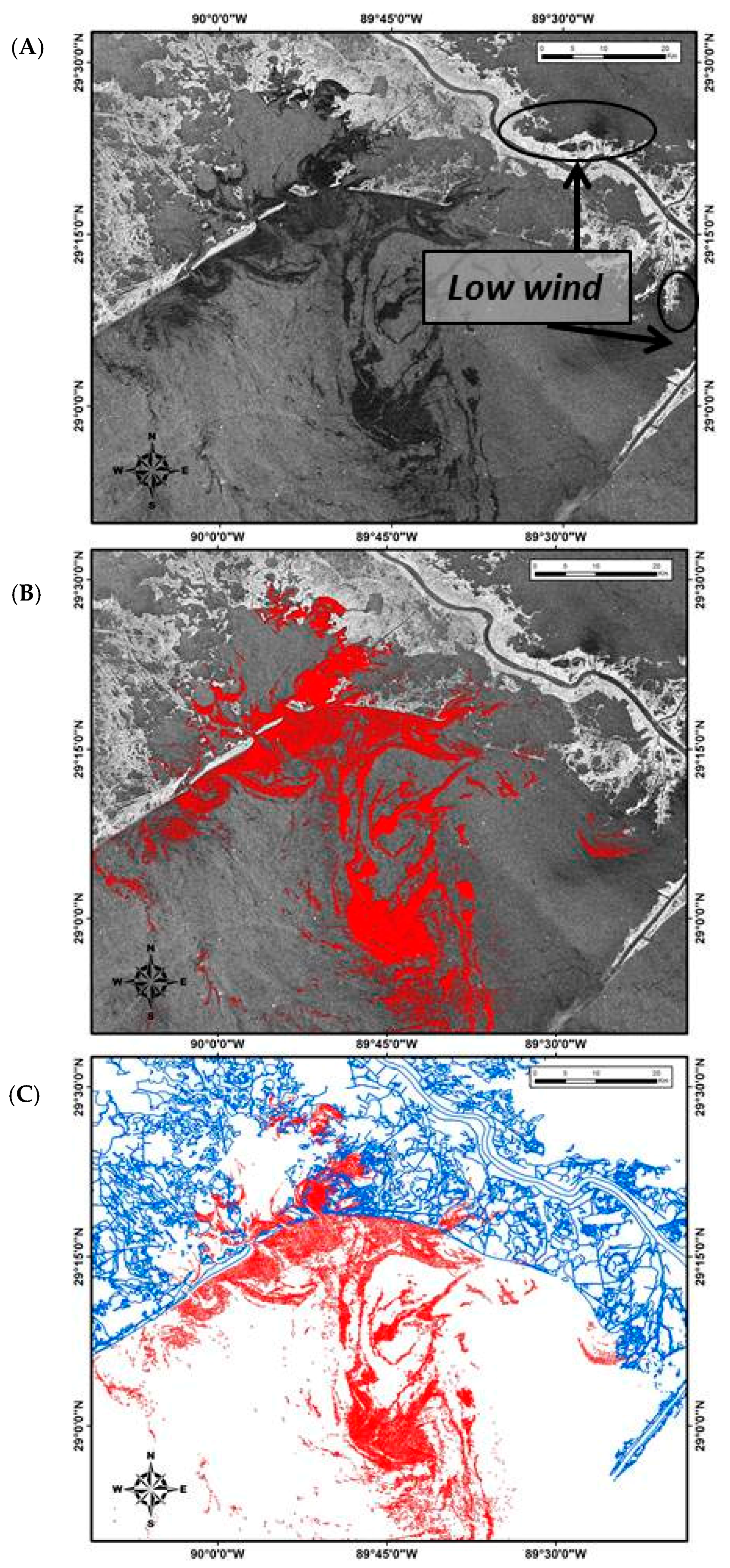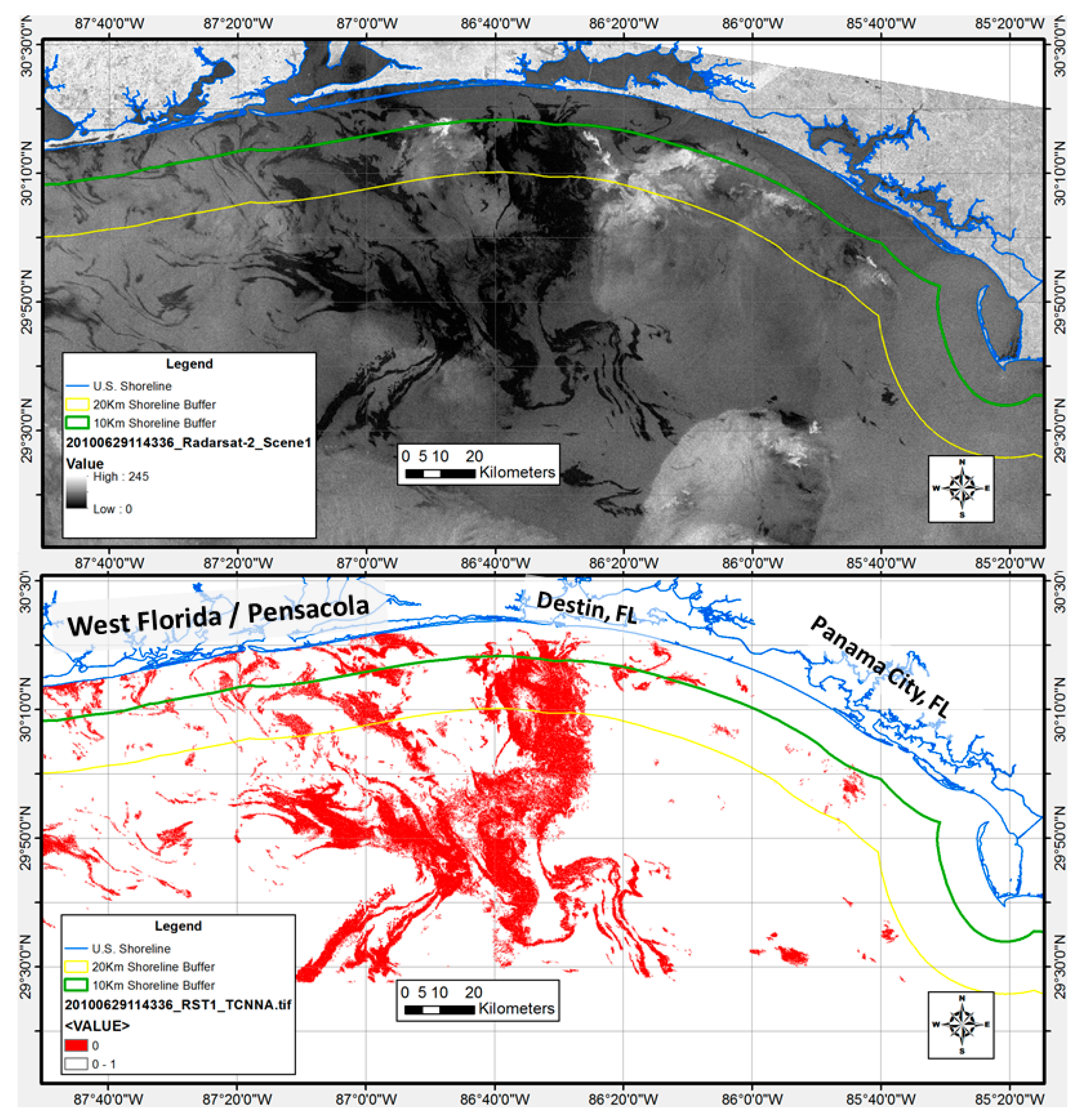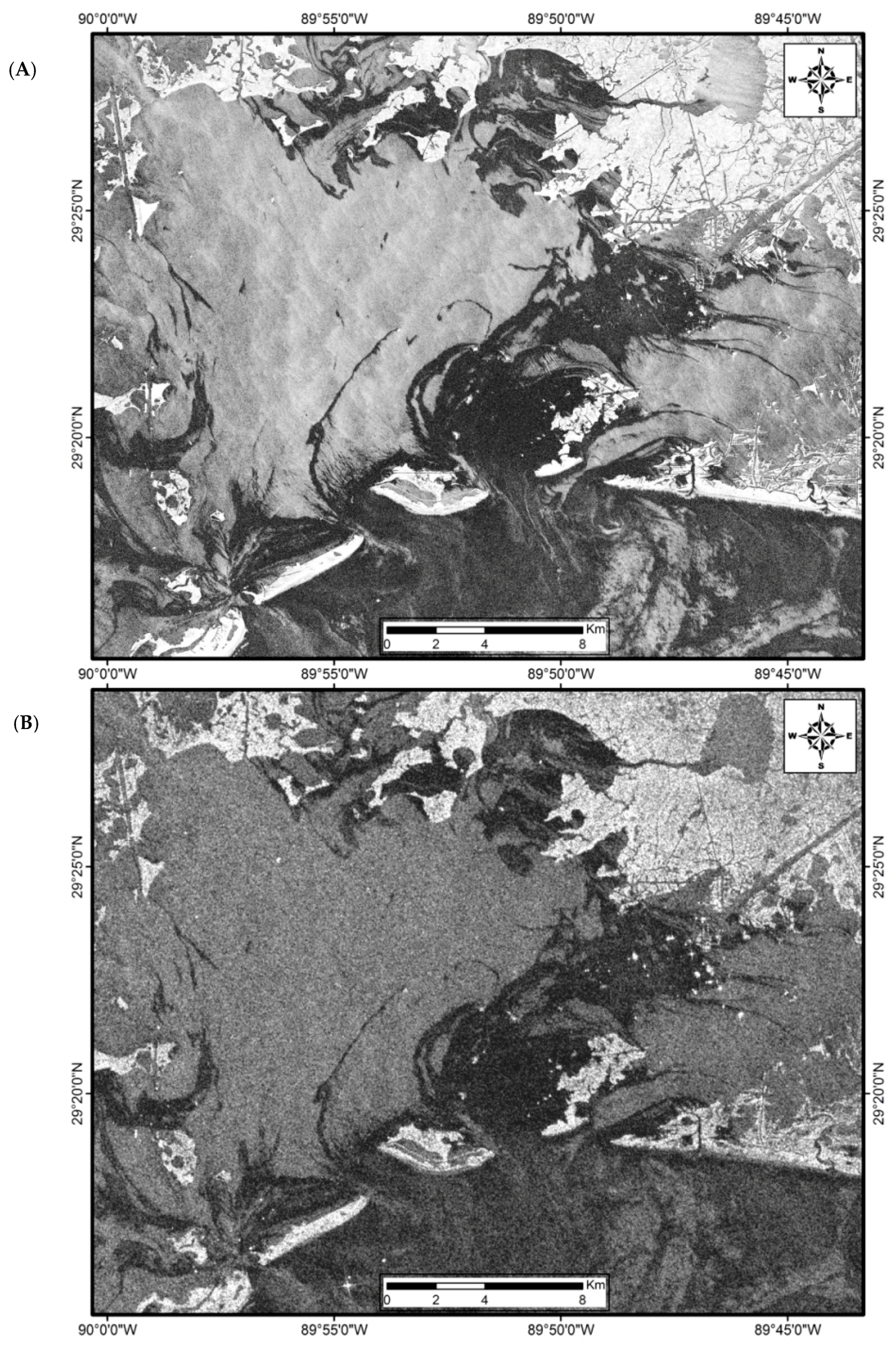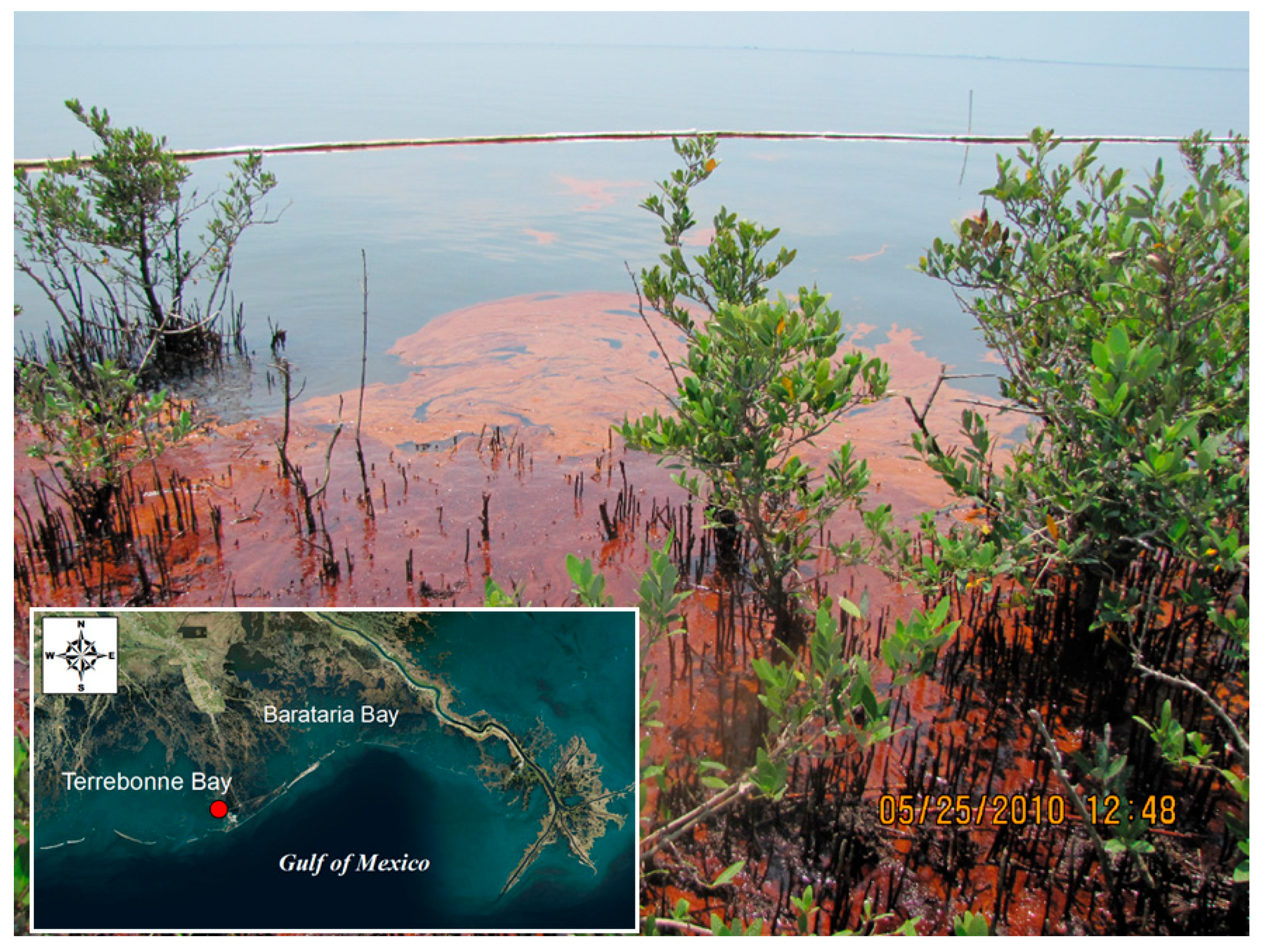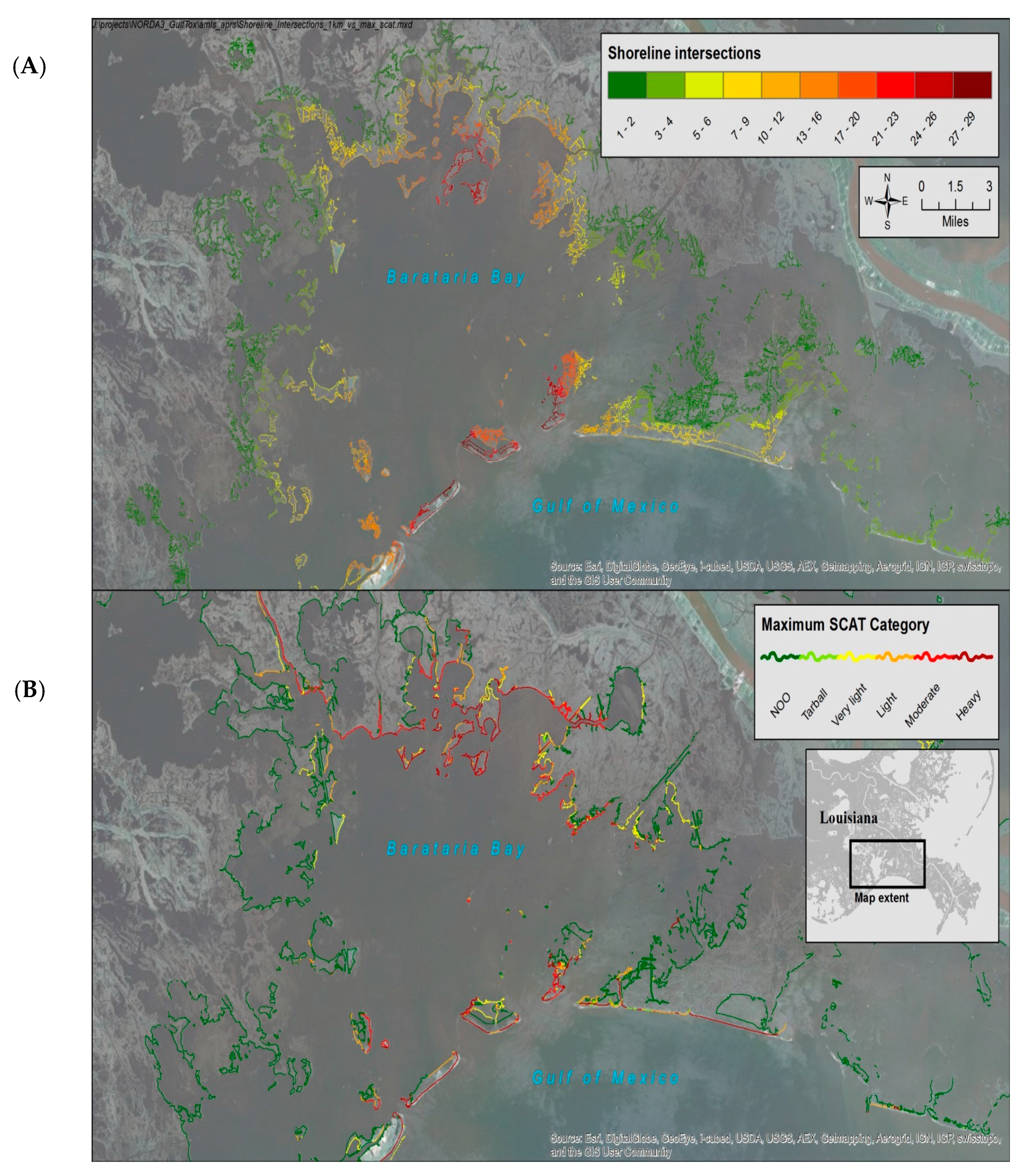2.1. SAR Overview
SAR satellites comprise active microwave high-spatial resolution sensors that operate across a range of frequencies including X-band (8–12 GHz, 2.5–4 cm), C-band (4–8 GHz, 4–8 cm) and L-band (1–2 GHz, 15–30 cm). As an active sensor, SAR’s transmitted electromagnetic field is controlled for amplitude, phase, and polarization. These characteristics are also measured for the received field, which, after proper coherent processing of the raw signal, yields a high-spatial resolution complex reflectivity map of the observed scene [
19].
Image amplitude is a response to the microwave signal backscattering properties of the ocean surface. The backscatter measured by a SAR sensor is a function of radar incidence angle, which is the angle between the incident radar beam and the vertical intercepting surface. For ocean imaging, the energy detected by the SAR antenna shows a stronger influence of Radar Cross Section (RCS). The RCS is a measure of the power scattered in a given direction when a target is illuminated by an incident electromagnetic wave [
20]. The RCS is normalized to the power density of the incident wave at the target so that it does not depend on the distance of the target from the illumination source. As the energy incident angle increases (with respect to nadir), the RCS also increases and less energy per unit area is reflected back to the satellite [
5]. This effect produces SAR ocean images with a gradient of decreasing brightness from the near-nadir to the far-nadir sides of the image [
8].
An image of the sea surface typically shows local variation in roughness, which is a function of wind waves and swell. Surface oil modulates the fine-scale roughness and enhances specular reflection from the sea water surface under the oil. This results in a signal that is locally less intense than from the surrounding oil-free water, thus making the oil slick in SAR imagery appear darker than water [
7,
21]. When the sea surface roughness is dampened or smoothed by viscoelastic properties of an oil slick or any other surfactant, incident energy from the SAR spacecraft is reflected away from the sensor, reducing radar backscatter. Therefore, oil-covered areas usually have distinctly contrasting brightness against the radar backscatter produced by wind-generated ripples [
6]. The visual differences among the satellites images (
Figure 1) are based on the specific configuration of the satellites including: wavelengths, spatial resolution, incidence angle, specific weather conditions present at the moment of the SAR snapshot, and the instrument noise floor.
The example images in
Figure 1 cover the west side of the Mississippi River “bird’s foot” peninsula and the Barataria Bay region of the central Louisiana coast. In all of the examples, floating oil (dark areas on the imagery) is present inside and outside of the bay. Because of geometry factors (commonly known as a double bounce effect of the backscatter), land areas are very bright features on SAR imagery, although this brightness can be more or less contrasting depending on the beam angles and wavelengths.
Figure 1 illustrates some of the differences and similarities observed by SAR sensors. The area covered in the six images is approximately the same, but the data vary by sensor. The primary differences are frequencies, pixel resolution, incidence angles, and noise floor. We note that three of the satellites used during DWH—Envisat (
Figure 1C), RADARSAT-1 (
Figure 1B), and ALOS-1 (
Figure 1E)—are no longer operational. However, all three satellites have been or are currently being replaced by successor instruments (SENTINEL-1, RADARSAT-2, and ALOS-2, respectively).
On the satellites, the antenna for a SAR system is designed so that the transmitted and received radar waves are vertically (V) or horizontally (H) polarized. In marine applications, the most appropriate single-polarimetric SAR mode is VV; the first V indicates transmission of an electromagnetic field temporally oscillating along a vertical plane relative to the SAR antenna, and the second V indicates vertical received polarization [
3]. Current SAR systems have polarimetric diversity, including several unique sets of polarimetric modes. Single-polarization is no longer limited to co-polarized images; a cross-polarized image such as VH or HV can now be obtained. In dual-polarimetric mode, one (or two) linear polarization(s) is transmitted and two (or one) linear polarization(s) are received, resulting in three optional pairs of co- and cross-polarized images: HH and HV, VV and HV, or HH and VV. Finally, in the full-polarimetric mode, the SAR antenna transmits and receives vertically and horizontally polarized electromagnetic fields so that a full scattering matrix can be measured, resulting in HH, VV, HV and VH images. This mode is usually referred to as quad polarization (or “Quad Pol”) and is available on RADARSAT-2 [
19] and ALOS-2.
Detection of an oil slick will vary depending on the sensor wavelength and configuration. For example, a short wavelength X-band (
Figure 1D,F) is more sensitive to smaller variations on the surface geometry and generally produces a higher contrast between floating oil and the surrounding clean water. However, X-band imagery can contain a considerable amount of speckle noise. In contrast, a longer wavelength L-band (
Figure 1E) introduces less weather factor noise (e.g., rain cells) on the imagery by increasing the size of the sampling frequency. Because of the longer wavelength, the image is smoother and shows less speckle.
At the time of this writing, the satellite with the best signal-to-noise ratio is RADARSAT-2 (
Figure 1A). COSMO-SkyMed satellites, on the other hand, typically include antenna patterns that incorporate significant noise on the imagery (
Figure 1F). The satellite with the highest spatial resolution used during the DWH event was TerraSAR-X (
Figure 1D), with a resampled spatial pixel resolution of approximately 2.3 m. All of the SAR satellites are capable of aiming at different areas within the range of the viewing angles, and expanding or contracting the area covered, which results in a corresponding decrease or increase of the spatial resolution. For example, the high resolution in TerraSAR-X (
Figure 1D) allows for the capture of the fine detail features of floating oil, but reduces the areal extent of the image footprint to only 32 km wide. In contrast, for images collected during DWH, the approximate resolution of the resampled pixel size for RADARSAT-2 was 25 m (ten times more than TerraSAR-X), while COSMO-SkyMed’s ScanSAR resolution was 30 m. The image swath of these two satellites was approximately 300 and 200 km, respectively.
When using SAR to detect oil in proximity to coastal areas, sensor parameters such as noise floor, spatial resolution, polarimetry, and viewing angles are crucial factors on the ability to discern oil from other look-alikes. Since oil slicks produce a specular reflector of the sea surface, the noise floor of the SAR sensor limits the distinction of the oil from other features when there is lack of gravity or capillary waves generated by wind [
7]. The conditions needed for the detection of oil in SAR imagery in proximity to the shoreline are a function of the signal to noise ratio, which is often driven by the noise floor of the SAR sensor. At the time of this writing, the SAR sensor with the highest resolution, noise floor, and signal to noise ratio is UAVSAR (
Figure 2A). This L-Band SAR sensor is mounted on an airplane and was used during the DWH to identify oil in proximity to the nearshore environment [
22]. UAVSAR typically collects SAR data with quad polarization, which allows a more advance processing by obtaining the phase among polarizations and therefore the capability to apply multiple post-processing algorithms. The research and development of UAVSAR at JPL-NASA has application to satellite-based SAR sensors as well. For example, Minchew et al. [
23,
24] detected oil emulsion mixtures using UAVSAR. Garcia-Pineda et al. [
13] applied a similar analysis to SAR satellite data to detect emulsified oil on the ocean surface.
The example shown in
Figure 2 is a sequence of UAVSAR collected on 23 June 2010 (
Figure 2A) followed by RADARSAT-1 (
Figure 2C) collected over the same area on two days after on June 25.
Figure 2B corresponds to the same area covered by the red outline inside
Figure 2C. Jones et al. [
22] originally presented this UAVSAR subscene to demonstrate the ability of aerial UAVSAR to detect oil near the shoreline. The image on
Figure 2B is showing the averaged intensity (green) and entropy (red) from the Cloude-Pottier polarimetric decomposition in the vicinity of Elmer’s Island, Louisiana, immediately southwest of the barrier islands shown in
Figure 2B. Oil can be seen along the beaches of the island while a large oil mass approaches the shore. This sequence shown by
Figure 2A,B suggests that oil persisted in the nearshore environment for more than 36 h.
2.2. SAR Image Processing
Numerous SAR satellites collected imagery from the northern Gulf of Mexico during the DWH spill. We obtained 710 SAR images collected between 23 April and 12 August 2010, each covering an area in the northern Gulf of Mexico where oil was detectable at some point during the spill. To analyze for the presence of oil near the shoreline, we initially identified 292 SAR images that appeared to contain oil within 25 km of a shoreline. Based on previous studies that described the optimal weather conditions for detecting oil in SAR imagery [
7,
12], we selected a subset of 188 images with weather-compliant conditions (winds from 3–8 m/s) and appeared to contain floating oil from the DWH. The SAR imagery used in this analysis was collected by RADARSAT-1, RADARSAT-2, TerraSAR-X, COSMO-SkyMed 1-2-3-4, Envisat, ALOS-1, and ERS-2 satellites (
Table 1).
Data were obtained in a wide range of formats including N1 (Envisat), Level1-SIO, GeoTIFF 8 bit, and GeoTIFF 16 bit. Based on the format of the SAR data available, we used four different remote sensing analysis tools to inspect the imagery on its highest available radiometric resolution: Matlab Imaging-Mapping Toolbox, IDL Image Library, MapReady, and ESRI ArcMap.
We inspected the entire catalog of 710 images, which included images collected over a wide range of weather conditions.
Figure 3A shows a sub-scene from a SAR image collected by RADARSAT-2 on 21 July 2010 at 23:52 UTC. On this SAR snapshot, oil is detectable within 1 km of the shoreline of the Mississippi delta when Station PSTL1 from the NOAA National Data Buoy Center (NDBC) registered a wind speed 9.4 m/s with gusts above 10 m/s. As reported by Garcia-Pineda et al. [
12], DWH oil was observed on SAR images even at winds of 20 m/s in the open water during storm events. The strong winds and the intense turbulence of the surface water that prevailed for several hours were unable to dissipate the massive amount of floating oil. On the other hand, unfavorable weather conditions for oil-water discrimination were commonly observed.
Figure 3B shows a SAR sub-scene collected by RADARSAT-2 on 1 June 2010, at 12:01 UTC. In this case, low wind conditions prevailed for several hours; the Station PSTL1 registered 1.6 m/s at the time of the SAR snapshot. In such low-wind conditions, oil is usually not discernable. For this study, such images were discarded.
For this study, we discarded nearly 75% of the DWH imagery for a variety of reasons, including in particular when meteorological conditions interfered with the ability to detect oil. Particularly during the summer, the sea surface temperature of the GOM favors the formation of storms. Floating oil is difficult and sometimes impossible to be delineated under rain cells or turbulent waters generated by fronts or tropical storms.
Figure 4 shows an example of stormy weather that complicates the delineation of oil. Mesoscale storms on the open water usually generate an imbalance of the wind, producing rain cells and pockets of strong winds (which mask the surface oil) with nearby areas of low wind (where oil slicks cannot be discerned). The operating minimum wind threshold for the TCNNA algorithm is above 2 m/s [
12]; SAR images outside this weather condition (e.g., dark areas of
Figure 4) were not included in this analysis.
The 188 selected images were processed for segmentation of floating oil using the TCNNA. This algorithm utilizes input data in GeoTIFF format, rescaling the radiometric resolution within a pixel range. Therefore, the selected imagery was converted to 16-bit GeoTIFF format, or we used 8-bit GeoTIFF format when raw SAR data was not available. The TCNNA semi-automated routine filters a grayscale image with a variable boundary kernel size (typically a 25 × 25 pixel kernel or larger, depending on the spatial resolution) for edge and shape detections based upon the Leung-Malik filter bank [
7,
12]. The neural network algorithm interpolates these detections within a training set previously compiled by an expert operator through classification of several thousand pixels from the same images under analysis.
SAR detection of oil on the sea surface relies on the damping effect of the oil on the Bragg waves. However, the observed reduced radar backscatter on the sea surface is not unique to oil. Low winds, biogenic films, wind sheltering by land or submerged structures, grease ice, internal waves, ship wakes, and convergence zones can also create areas of reduced radar backscatter [
19]. In addition, thunderstorms, rain, as well as atmospheric and oceanic fronts can affect the surface roughness and produce so-called “look-alike” features (
Figure 5). Furthermore, oil on the sea surface is subjected to a number of processes including evaporation, dispersion, emulsification, dissolution, oxidation, sedimentation, and biodegradation. For these reasons, the detectability of oil with SAR is sensitive to the source of the oil, the current environmental conditions, and the history of the sea surface in localized areas [
12,
13].
In this study, a supervised evaluation of each image was required to identify and remove image regions unsuitable for analysis. SAR images cover large areas (in some cases swaths 450 km wide) and weather conditions vary on regional scales. Although all of the images used in this analysis clearly showed the presence of floating oil, in some cases portions of SAR images were obscured due to sensor noise or other issues with the raw image data. Under local conditions of low or zero wind, substantial regions of an image would sometimes appear radar-dark in the absence of capillary waves on the ocean surface. In some images, regions of noise or low wind were masked off from the surrounding image features to avoid false-positive classifications; these areas were classified as no-data regions on the image. Screening filters (land masks) were used to prevent false positive oil detections on land.
Since the neural network classifier operates on a per-pixel basis, the TCNNA output maintains the original spatial resolution of the SAR image. The fully implemented TCNNA routine produces a ~1 Mbyte georeferenced raster image in which all pixels have a binary classification of either floating oil or not floating oil. Resolution of individual pixels depended upon the satellite, collection mode, and incidence angle, but was generally in the range of 12.5 to 75 m. These images with binary classifications were produced in GeoTIFF format, preserving the projection and datum of the input SAR image (e.g., UTM and NAD83). TCNNA GeoTIFF outputs were then converted to ESRI ArcMap shapefiles and if necessary re-projected to the NAD83 datum to standardize all the outputs. The resulting TCNNA shapefiles were then inspected for false positives.
2.3. Identification and Removal of False Positives
For the false positive inspection, we first overlaid North American Mesoscale (NAM) wind model outputs on the TCNNA and SAR images layers in GIS for visual inspection. Additionally, we used direct wind and atmospheric measurements from the nearest weather and buoy stations from the NDBC. The SAR image and TCNNA-detected oil areas were then inspected for features (dark patches on the SAR images) that might have been created by areas with wind speeds <2 m/s.
Although the NAM wind model outputs and NDBC data were useful reference data for identifying potential low wind areas, these data sets were typically at much lower resolution than the underlying SAR image. Thus, low wind features (false positives) had to be identified in a supervised classification based on the additional lines of evidence, including texture and proximity to land (
Figure 5). In particular, low backscatter signatures can be generated when land obstructs the flow of the wind required to generate capillary waves on the sea surface. A trained image analyst can identify these features by looking at the gradient of the pixel values at the edge of the dark feature. Normally, floating oil will have a higher contrast between the edge of the slick and the surrounding waters (
Figure 5A). The TCNNA algorithm will normally flag low wind features, and the analyst has the option of removing all or some of the flagged pixels [
7,
12]. The algorithm uses the statistical descriptors of the neighbor pixels under analysis in search for variances on the strength of the backscatter. Although the algorithm flags the majority of the low wind features, some areas require the analyst to inspect the output for quality assurance. Most of these cases occur on areas shadowed by land or behind islands. In these areas, we used a high resolution land mask [
25] to remove low backscatter features created by land.
When low wind regions were indicated by low modelled wind in the NAM, observations from buoys and weather stations, and confirmed in the TCNNA outputs, these regions were manually removed from the original TCNNA output. In cases where large low wind regions were intermixed with the oil area and boundary-specific demarcation between oil and low wind was difficult, the entire SAR image was discarded from the analysis.
Other features can generate false positives in addition to low wind. For example, rain cells often generate regions of low backscatter (particularly on shorter wavelength X-Band). Low altitude barrier islands or very shallow marshes may also create low backscatter on the SAR image (especially on longer wavelength L-Band). The supervised classification step included close inspection of TCNNA output to ensure that these common false positives were not present.
Figure 5A–C shows the flow of the SAR data analysis: (
Figure 5A) general visual inspection of the SAR imagery; (
Figure 5B) overlay of the TCNNA output for removal of low wind features; and (
Figure 5C) overlay of the high resolution land and bathymetry layer for land masking and removal of low backscatter caused by land obstruction.
After the initial inspection of the TCNNA output, we conducted a detailed review for false positives by projecting the TCNNA output against a high resolution shoreline polygon in order to reveal those generated by land mass (
Figure 5C). During this identification process, the geographic registration of the TCNNA output layer was carefully inspected and adjusted when necessary. The overlaying of the high resolution land and bathymetry layer allowed for the identification and removal of areas with low backscatter caused by land obstruction.
